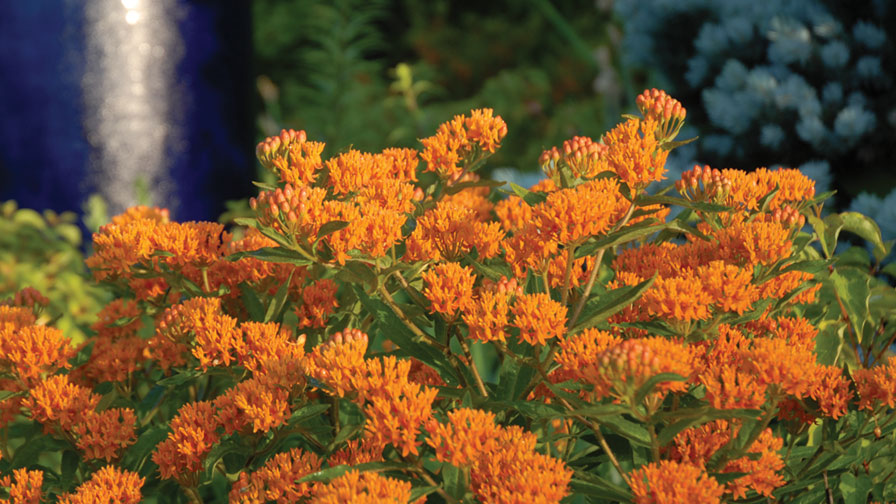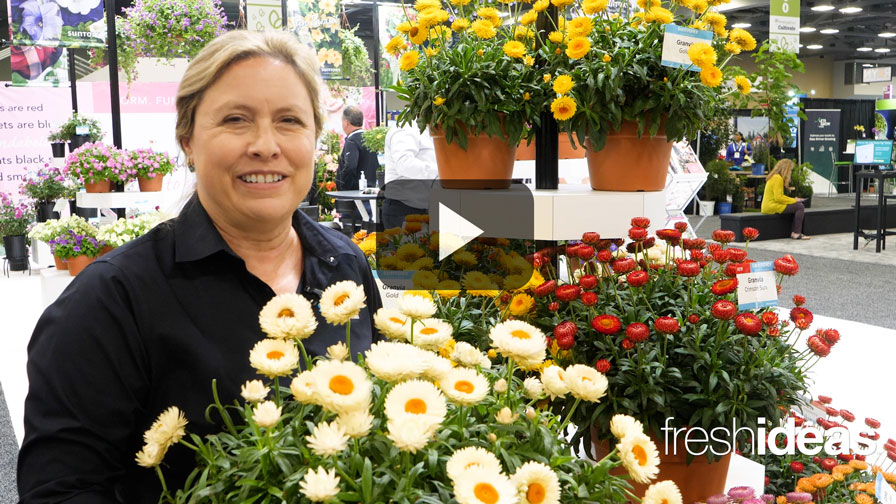Greenhouse Growing Tips for Asclepias tuberosa

Asclepias tuberosa stands out in a bioswale at North Creek Nurseries.
Asclepias tuberosa is the 2017 Perennial Plant of the Year. It is a robust, drought-tolerant native, also known as butterfly weed, that attracts butterflies and hummingbirds to the garden, especially Monarch butterflies. Recent declines in Monarch butterfly populations have put A. tuberosa in the spotlight. The symbiotic relationship between the native milkweed plants and the Monarch is vital. Monarchs cannot survive without milkweed; caterpillars only eat milkweed plants (Asclepias spp.), and Monarch butterflies lay their eggs on milkweed foliage. Shifting land management practices have resulted in milkweed plants disappearing from the landscape.
Demand for A. tuberosa is on an uptick and will continue to trend for several reasons. In addition to its recognition as the 2017 Perennial Plant of the Year by the Perennial Plant Association, organizations such as Monarch Red Carpet (https://www.monarchredcarpet.org/) and Pollinator Partnership (http://www.pollinator.org/) are working to increase populations of Asclepias and support the migratory paths of monarchs by protecting and promoting the importance of pollinators. The Monarch migration to central Mexico is a long haul and these ‘feeding corridors’ provide nourishment for a successful journey.
Another worthwhile effort is The Million Pollinator Garden Challenge (MPGC), which is a project of The National Pollinator Garden Network, a nationwide call to action to preserve and create gardens and landscapes that help revive the health of bees, butterflies, birds, bats and other pollinators across America. The initiative will move millions of individuals, kids, and families outdoors and make a connection between pollinators and the healthy food people eat.
Asclepias tuberosa is an excellent performer that stands out in North Creek Nurseries’ bioswale plantings. It is the operation’s most requested, top-selling milkweed, followed closely in the past four years by A. incarnata and A. syriaca. Top-selling cultivars are A. incarnata ‘Ice Ballet,’ A. tuberosa ‘Gay Butterflies,’ and A. tuberosa ‘Hello Yellow.’

Madeline Maynor of North Creek Nurseries
Madeline Maynor is the Growing Operations Manager for Landenberg, PA-based North Creek Nurseries. She says the nursery has found the greatest success with propagating A. tuberosa when seed is sown in Week 6. When it comes to finished production, this species is the most finicky of all Asclepias because of day length and temperature requirements. Plants will respond to shearing; however, they will require six additional weeks to flower. It is best to start with a well-branched liner.
If you have to overwinter A. tuberosa, Maynor recommends overwintering them in unheated cold frames, preferably in 30°F to 35°F range. Proper moisture management is key. Manage the moisture to the drier side, she says, and never over saturate.
Maynor’s recommendations for growing Asclepia tuberosa successfully:
Fertilizer: A. tuberosa fits well with other perennial fertilizer programs. It has low EC requirements, so run lean.
Propagation: Do not disturb the root system when transplanting from liners to 1-gallon production.
Plant Growth Regulators (PGRS): None required.
Irrigation: Moisture management is key. Manage moisture to the drier side, allowing plants to dry out between waterings.
Planting/Scheduling: Sow in Week 6. LP50 liners finish in Week 12. Growers should be potting Week 12 to 16. It takes 10 weeks to finish a 1-gallon container. A. tuberosa shows early summer bench color. For summer-produced containers, overwinter containers for earlier season sales. Don’t forget to include descriptive tags for POP sales.
Pests: Along with attracting butterflies, it also attracts pests. Don’t be alarmed when you see aphids. We’ve found that a combination of preventative measures are key when growing A. tuberosa because pests such as thrips and aphids are present more so than not. Growers should not use neonicotinoids as a pest control. Neonicotinoids have been found to kill feeding monarch caterpillars. Best control for insect pests such as aphids would be to use natural soaps and horticultural oils that do not persist on the foliage.
At North Creek, our first course of action is biologicals to control pests; we use trapping, banker plants, and sticky tape. The banker plants serve as a habitat from which the beneficial insects are released. We use sashes on every liner. Sashes are packets of beneficial mites and are replaced on a four-week interval.
Our product mix provides food and habitat for wildlife. In keeping with our mission, every effort is made to grow plants in the safest and most sustainable way possible. Our use of beneficial insects is the frontline preventative and always the first step in our Integrated Pest Management (IPM) program.
About North Creek Nurseries:
Located in Landenburg, PA, North Creek Nurseries is Greenhouse Grower’ s 2016 Operation of the Year. Its mission is to propagate and market plants that develop the relationship between people and sustainable outdoor environments. As a wholesale propagation nursery, North Creek specializes in growing starter plants or plugs of perennials, ornamental grasses, ferns, vines, and shrubs, with an emphasis on Eastern U.S. native plants.
North Creek Nurseries’ plants are used by wholesale growers and landscape contractors. The company’s trademarked Landscape Plugs provide planting solutions for ecological projects including storm water management, soil stabilization, landscape restoration, and habitat establishment.

Asclepias tuberosa









